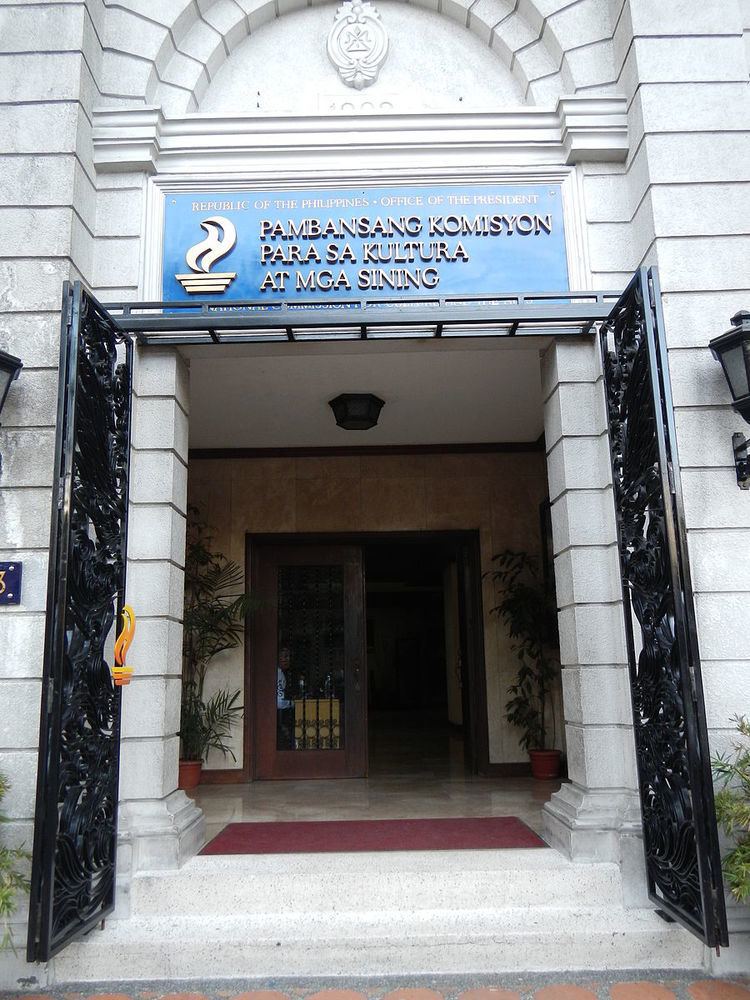Formed 1987 | Employees 210 | |
 | ||
Preceding agencies National Commission on CulturePresidential Commission on Culture and the Arts Jurisdiction Philippine arts and cultural development Headquarters NCCA Building, 633 General Luna Street, Intramuros, Manila | ||
The National Commission for Culture and the Arts of the Philippines (Filipino: Pambansang Komisyon para sa Kultura at mga Sining, Cebuano: Nasodnong Komisyon alang sa Budaya ug mga Arte), is the official arts council for the Philippines. It is the overall policy making body, coordinating, and grants giving agency for the preservation, development and promotion of Philippine arts and culture; an executing agency for the policies it formulates; and task to administering the National Endowment Fund for Culture and the Arts (NEFCA) -- fund exclusively for the implementation of culture and arts programs and projects.
Contents
History
The successful overthrow of the Marcos administration in 1986 inspired the different sectors of society to rally behind the new government towards the restoration of democracy. In March 12, 1986, the Alliance of Artists for the Creation of a Ministry of Culture (AACMC) drafted and adopted a proposal for the establishment of a Ministry of Culture. The group cited the inability of the Ministry of Education, Culture, and Sports to devote time and attention to cultural planning due to the gargantuan task of addressing the problems of the educational system.
President Corazon Aquino responded by issuing Executive Order 118 on January 30, 1987 which established the Presidential Commission on Culture and the Arts (PCCA). It was a diminutive agency compared to the proposal of AACMC but the said order was cognizant of the existence of specialized cultural agencies and that these should only be placed under the umbrella of one agency to coordinate their efforts.
In 1992, under the new constitution, Congress enacted Republic Act No. 7356 which institutionalized the establishment of the National Commission for Culture and the Arts (NCCA) replacing PCCA. This said law mandated the formulation of national cultural policies and programs according to the following principles:
a) pluralistic, fostering deep respect for the cultural identity of each locality, region or ethno-linguistic locality, as well as elements assimilated from other cultures through the natural process of acculturation;b) democratic, encouraging and supporting the participation of the vast masses of our people in its programs and projects;c) non-partisan, open to all people and institution, regardless of creed, affiliation, ideology, ethnic origin, age, gender or class, with no organized group or sector having monopoly of its services; andd) liberative, having concern for the decolonization and emancipation of the Filipino psyche in order to ensure the full flowering of Filipino culture.The establishment of the NCCA prompted the cultural agencies that were attached to it, by virtue of the same law, to review its existing mandates and programs to harmonize the delivery of cultural services. CCP, for its part, transformed itself to become the national coordinating center for the performing arts. It also sought to remove its “elitist” image by strengthening its outreach programs and developing partnerships with local arts councils.
Board of Commissioners
As governed by RA 7356, The National Commission for Culture and the Arts is governed by a Board of Commissioners composed of 15 members, namely:
Activities
The Commission is responsible for the administration of two state honors: the National Living Treasure (Philippines) and the National Artist of the Philippines. It also confers organizational awards such as the Ani ng Dangal, Dangal ng Haraya, and the Alab ng Haraya.
It is also responsible for the annual celebration of the National Arts Month (February), UNESCO-ITI World Theatre Week (March 21-27), National Heritage Month (May), National Dance Week (Fourth Week of April), National Literature Month (April), Linggo ng Musikang Pilipino (Last Week of July), Indigenous Peoples Month (October), Museums and Galleries Month (October), and Library and Information Services Month (November).
Logo
The NCCA logo is the Alab ng Haraya (The Flame of Imagination), which symbolizes the spring of Filipino art and culture. It is composed of two basic elements – the fire and the censer. The fire is a stylized character "ka" of the Philippine indigenous script Baybayin, that stands for kadakilaan or greatness. The fire represents the highest level of imagination and emanates from a three-tiered censer. The three tiers stand for organization, economic support, and an orientation rooted on a thorough grasp of tradition and history, which the NCCA provides. It is done in gold to symbolize the immense wealth of Philippine culture.
